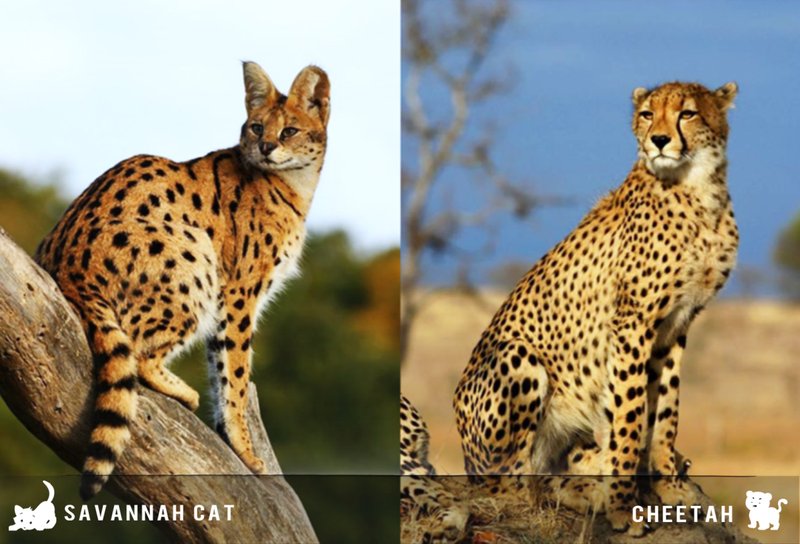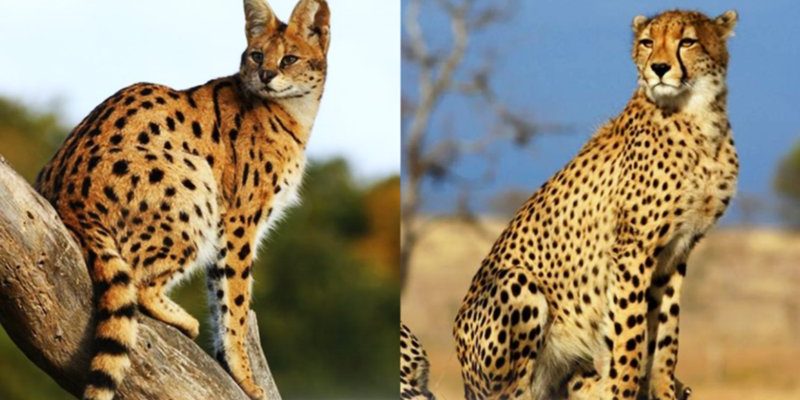
In this post, we’ll dive into ten animals that are similar to the cheetah. We’ll explore their features and habits, and I’ll show you how to tell them apart. Whether you’re an animal lover, a curious mind, or someone preparing for a visit to the zoo, this exploration will shed some light on our feline friends and their look-alikes. So, grab a cup of coffee, settle in, and let’s get started!
The Leopard: A Close Relative
Leopards are one of the closest relatives to the cheetah, sharing much of the same habitat across Africa and parts of Asia. Just like cheetahs, leopards are skilled hunters, but there’s a key difference: leopards are built for strength rather than speed. While a cheetah’s slender body is designed for sprinting, a leopard’s muscular build helps it climb trees and take down larger prey.
You might spot a leopard by its distinctive rosettes—black spots arranged in a circular pattern. Cheetahs, on the other hand, have solid black spots covering their golden coats. If you see a big cat lounging lazily in a tree, chances are it’s a leopard, not a cheetah. They often prefer to stake out their territory in trees, where they can watch for unsuspecting prey below.
Habitat and Behavior
Both animals are found in similar habitats, like savannahs and grasslands. However, leopards are more adaptable and can survive in different environments, including rainforests and arid deserts. They also hunt more opportunistically, employing stealth and patience. So, if you want to differentiate between the two, observe their hunting style: the leopard’s strategy is more about ambushing and pouncing rather than all-out speed.
The Lion: The King of the Jungle
Next up is the lion, the iconic big cat known for its majestic mane and prideful social structure. While lions are part of the same family (Felidae) as cheetahs, they’re quite different in behavior and appearance. Lions are larger and have a more robust body, while cheetahs are lighter and more agile.
You might say that lions are the “team players” of the feline world, often living in groups called prides. In comparison, cheetahs are more solitary and sometimes found in small groups, mainly mothers with cubs. If you spot a cat lounging with a group, you’re likely observing lions rather than cheetahs.
Features to Notice
In terms of physical traits, male lions have a distinctive mane, while female lions are slightly smaller and lack this feature. Cheetahs don’t have this mane at all, making them look sleek and streamlined. Their characteristic “tear stripes” running from their eyes to their mouths are another visual cue that sets them apart from lions.
The Jaguar: Power and Grace
The jaguar is another big cat that bears a resemblance to cheetahs, especially in their spotted coat. Jaguars have a strong, stocky build and are excellent swimmers, often hunting in water. Unlike cheetahs, which rely on speed for a quick sprint to catch prey, jaguars use incredible strength and powerful jaws to take down their next meal.
While both cats display stunning spots, jaguars have larger rosettes with central spots, giving them a unique look. Their habitat primarily includes dense rainforests, rivers, and swamps, while cheetahs typically roam the open grasslands of Africa.
Hunting Techniques
Jaguars are known for employing a sneak-attack style of hunting, often stalking through the water. In contrast, cheetahs rely on sheer speed and acceleration. When these two different strategies are at play, observing the environment can lead to identifying which animal you might be watching.
The Serval: The Tall Cat
Servals are medium-sized wild cats that might not be as famous as cheetahs, but they share their own unique traits. These cats have long legs and large ears, which help them hear their prey moving through grass. Although smaller than cheetahs, they share a prominent feature: the spotted coat.
You can easily tell a serval apart from a cheetah by their size and appearance. Servals are much smaller and have a more defined face. They often hunt small mammals and birds, utilizing their incredible jumping ability to catch prey. If you ever see a cat leaping high in the air, it’s likely a serval!
Behavioral Differences
While cheetahs sprint at incredible speeds to catch their meals, servals rely on stealth and patience. Their hunting strategy involves stalking and pouncing rather than outrunning their targets, which differentiates them from cheetahs.
The Caracal: The Desert Hunter
Caracals are fascinating cats that resemble servals but are more robust and have distinct tufted ears. Like cheetahs, they are also agile hunters but prefer to live in arid environments, such as savannahs and semi-deserts. Caracals are known for their incredible leaping ability, allowing them to take down birds in mid-flight.
The difference in size and distinct ear tufts helps set caracals apart from cheetahs. While cheetahs are built for speed, caracals pack a punch when it comes to strength and agility.
Hunting Style
Caracals often hunt in pairs or alone, but they’re more adaptable than cheetahs when it comes to hunting techniques. They can leap up to three times their body length to catch prey, showcasing their strength and skill.
The Ocelot: The Small Spotted Cat
Ocelots are smaller than cheetahs, but they are known for their gorgeous, spotted coats resembling those of their larger relatives. Found primarily in Central and South America, ocelots have a unique blend of colors and patterns that make them quite stunning.
One major difference is in size: while ocelots weigh between 20 to 40 pounds, a cheetah can weigh between 75 to 140 pounds. The smaller stature of the ocelot allows it to be more agile in its jungle habitat.
Behavior and Adaptation
Ocelots are solitary and mainly nocturnal. They hunt small mammals, birds, and reptiles, relying on stealth rather than speed. Their adaptability to various environments contrasts with the cheetah’s preference for open plains.
The Snow Leopard: Masters of the Mountains
Snow leopards are a strikingly beautiful and elusive species that inhabit the high mountain ranges of Central and South Asia. Unlike cheetahs, which thrive in open areas, snow leopards are perfectly adapted to rocky terrains and cold climates. Their thick fur and long, bushy tails help them maintain balance and stay warm.
While both cats are spotted, snow leopards have a more muted coat of gray and black compared to the cheetah’s vibrant pattern. The snow leopard’s body is built for stealth and agility, allowing it to navigate steep slopes effortlessly.
Hunting in the Mountains
Snow leopards use a strategy similar to leopards but are more secretive in their approach. They rely on the element of surprise and the terrain to ambush prey, contrasting with the cheetah’s full-speed chase.
Exploring these ten animals similar to the cheetah reveals just how diverse and fascinating the world of big cats truly is. From the powerful jaguar to the agile serval, every species has its unique adaptations that make it special.
So, whether you’re an aspiring wildlife photographer, a nature enthusiast, or just someone who enjoys learning about animals, knowing the differences among these creatures enhances our appreciation for them. Next time you’re at the zoo or flipping through a wildlife documentary, you’ll have a new lens through which to view these incredible cats and their similarities to the cheetah. Remember, nature is a beautiful tapestry, and every thread tells its own story.

